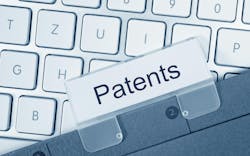With significant research and development advances the lifeblood of photonics science and business, having a firm grasp on intellectual property (IP) tactics and strategies can be crucial to benefitting from hard-won knowledge. Let’s start with some basics.
A patent, or “letters patent” to give it its full name, gives an individual unique marketing and selling rights that are not enjoyed by others. Patents have been around for hundreds of years and were used originally by monarchs to bestow monopoly privileges on the lucky few. It was a system open to abuse, where a king might grant a monopoly using a letters patent to an individual as quid pro quo for some favor given to the king. The situation in seventeenth-century England became so bad that public outcry forced King James I (and VI of Scotland) to revoke all existing monopolies. Parliament replaced this system under the 1624 Statute of Monopolies, after which letters patent could only be bestowed upon inventors or introducers of original inventions—and only for a limited time. Thus, in Britain, at least, patents became a vehicle for rewarding invention.
The idea that an inventor should be allowed to benefit from an invention was so important to the founding fathers of the U.S. that they encapsulated it in the Constitution in 1789. Article 1, Section 8, grants Congress the power to “promote the Progress of Science and useful Arts, by securing for limited Times to Authors and Inventors the exclusive Right to their respective Writings and Discoveries” (they thought copyright was important, too). Congress has since passed several laws addressing and updating the U.S. patent system, starting in 1790. Thomas Jefferson was, among other things, one of the first three patent examiners, and the first U.S. patent was issued in 1791 to Samuel Hopkins of Vermont for a method of producing potash.
The “exclusive right” these days includes the right to prevent others from making, using, selling, offering for sale, or importing into the U.S. an infringing product or process. This right is usually asserted by filing an action for patent infringement in federal court. The quid pro quo for being granted this right to exclude others is that anyone can make or use the invention after the patent has expired.
To ensure that the inventor holds up their part of the bargain, the patent must contain a description of the invention with sufficient detail that anyone can make or use it. Also, given that the patent is part of the public record, the information within the patent is permanently available and will not be lost. Note that a patent does not grant a right to an individual to sell a product; it grants only the right to exclude others. For example, the product itself may be covered by someone else’s patent. In this case, the inventor would need to negotiate an agreement with the other person that allows the marketing and sale of the product.
Where patents work—and why
Does the patent system really promote technological development? It depends in large part on what the technological field is. In some areas, where the product cycle is short, say less than five years, patent coverage for that product may be less important than other aspects, such as being first to market, branding and marketing effectively, or having a good sales network. Software is a good example of such a field, where a product evolves rapidly and may even be replaced before the patent covering it has been granted. In other areas where the product cycle is long, patent coverage may be almost essential. The pharmaceutical industry is one field where a patented product is often still being sold when the patents expire. Given the huge cost of developing a new drug and getting it approved, many pharmaceutical companies argue that the patent system is essential for letting them recoup their costs and making a profit over the lifetime of the patent.
How about photonics? I don’t know of any study relevant to our industry, so at a recent presentation to around 200 photonics executives, I asked those from a company that sold products covered by patents to raise their hands. I then asked those who raised their hands to keep their hands raised if they would still sell the products even if they had no patents. About 40% of them indicated they would. If this unscientific poll’s results represent the photonics community, then the usefulness of the patent system for photonics lies somewhere between its usefulness for the software and pharmaceutical industries.
Patents can have many uses other than incentivizing invention, however. For example, even if a company does not intend to assert its patents, a healthy patent portfolio may help obtain a cross-licensing solution to resolve an infringement accusation. Alternatively, an individual inventor who has no intention of developing or marketing a product can out-license their technology to generate income that allows them to keep on doing what they like to do—invent—while the licensee is the one who takes on the tasks of product development and marketing. (A future article will explore ways of using a patent portfolio.)
The patent system is not without critics. One of the major criticisms is that the costs of patent infringement litigation are too high, making patents useful only to large companies that can afford the millions of dollars it takes to fund a lawsuit. Another is the ability of non-practicing entities (NPEs, sometimes referred to as patent trolls) to buy patents cheaply and use them to sue companies for patent infringement, even though the NPEs do not themselves make any product or otherwise contribute to technological advancement: they exist only to make profits for their investors.
No matter where you find yourself on the spectrum of how useful patents are to your professional endeavors, I hope you will find the upcoming series instructional and interesting. Next month, we will look at the difference between patents and trade secrets, including the pros and cons of each, and discuss the situations where one may be more beneficial than the other.
This article is the author’s opinion alone and not that of Laser Focus World or Carlson Caspers. The information presented here should not be relied upon as legal advice.

